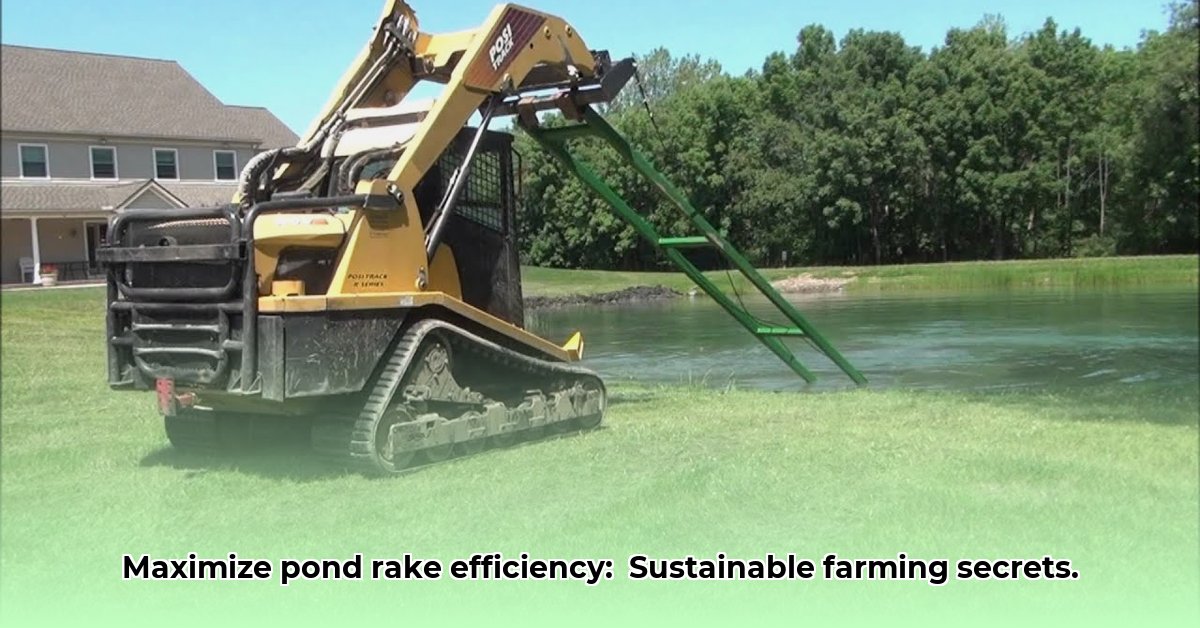
Choosing the Right Tractor Pond Rake: A Precision Match
Selecting the correct pond rake is crucial for efficient and sustainable farming. Consider these key specifications to ensure optimal performance and minimize soil compaction. For smaller ponds, consider a lawn tractor option.
Tine Type: The Teeth of the Operation
The tine (the "teeth" of the rake) design significantly impacts its effectiveness. Straight tines are gentler, suitable for light debris removal, while spiral tines are more aggressive, tackling stubborn muck and weeds. Curved tines offer a balance, effective for most situations. The ideal choice hinges on your pond's typical condition; a light cleanup needs different tines than a pond choked with sediment.
Rake Width: Balancing Coverage and Tractor Capacity
Wider rakes cover more ground faster, boosting efficiency. However, your tractor must possess sufficient power; a smaller tractor might struggle with a larger rake, hindering rather than enhancing the process. Match the rake width to your tractor’s capabilities and the size of your pond.
Gauge Wheels: Ensuring a Level Playing Field
Gauge wheels maintain the rake's levelness, critical for a smooth, even pond bed. This prevents uneven surfaces where water might pool. While increasing the initial cost, the precision and efficiency benefits often outweigh the expense. Consider if the added precision is necessary for your operations.
Three-Point Hitch: The Foundation of Secure Operation
The three-point hitch is the standard tractor attachment system. Ensure your chosen rake is compatible to ensure safe and easy installation and operation. A secure connection prevents accidental detachment and damage.
Operating Your Tractor Pond Rake: A Step-by-Step Approach
Safe and effective operation is paramount. Always inspect your equipment before starting.
Step 1: Pre-Operation Check: Visually inspect the rake for loose bolts, damage, and secure attachments. Check lubrication levels; proper lubrication is crucial for smooth operation and longevity.
Step 2: Secure Attachment: Attach the rake securely to your tractor's three-point hitch, strictly adhering to the manufacturer's instructions.
Step 3: Gradual Start: Begin slowly to get a feel for the rake and adjust to conditions. Sudden movements or excessive speed can damage the equipment or create uneven surfaces.
Step 4: Depth and Angle Adjustment: Adjust the rake's depth and angle to suit the pond's conditions. A shallower depth is suitable for light debris, while a deeper depth is needed for thicker sediment. The angle can be adjusted to optimize debris collection.
Step 5: Consistent Operation: Maintain a steady and consistent speed during operation. Avoid jerky movements.
Step 6: Post-Operation Maintenance: Clean the rake thoroughly, removing all mud, weeds, and debris to prevent corrosion and extend its lifespan. Lubricate moving parts as needed and inspect for damage.
Step 7: Proper Storage: Store the rake in a dry, protected place to prevent rust and damage.
Sustainable Practices with Tractor Pond Rakes: Environmental Stewardship
Utilizing a pond rake effectively promotes environmental sustainability.
Controlled Grading of Pond Banks
Controlled grading of pond banks prevents soil erosion, minimizing runoff and preserving topsoil. This reduces the risk of sediment entering the water, improving water quality.
Thorough Debris Removal
Thorough debris removal improves water quality, enhances aeration, and promotes healthier aquatic life.
Leveling Pond Bottoms
Leveling pond bottoms maximizes water storage capacity, reduces sedimentation, and improves water drainage. A level pond bed also promotes healthy water circulation.
These sustainable practices contribute significantly to long-term soil health, water conservation, and a thriving pond ecosystem.
Maintenance and Repair: Extending Equipment Lifespan
Regular maintenance is crucial for extending your rake’s lifespan, minimizing environmental impact (through reduced replacement needs), and preventing costly repairs.
- Regular Lubrication: Lubricate moving parts according to the manufacturer’s recommendations.
- Inspection for Damage: Inspect after each use for bent or broken tines, loose bolts, and worn components. Address small issues immediately to avoid escalating problems.
- Targeted Repairs: Perform necessary repairs promptly using manufacturer-recommended parts. Improper repairs can compromise safety and performance.
Cost Considerations: Long-Term Value and Return on Investment (ROI)
The initial investment cost varies depending on the features, size, and manufacturer. However, the long-term value significantly outweighs this cost.
Fuel Efficiency
Proper use and maintenance minimize fuel consumption. A well-maintained rake operates more efficiently, reducing fuel costs over time. Fuel efficiency is directly linked to the rake's design and operational technique.
Maintenance Costs
Regular maintenance prevents costly repairs. Preventative measures are far more cost-effective than major repairs.
Return on Investment (ROI)
The combination of environmental benefits, increased pond efficiency, and reduced maintenance and fuel costs contributes to a highly positive ROI over the rake's lifespan.
Case Studies: Real-World Successes
(Note: Space for future inclusion of real-world case studies demonstrating the benefits of efficient pond rake use and sustainable farming practices.)
Conclusion: Embrace Sustainable Pond Management
Investing in a high-quality pond rake is a strategic decision for environmentally conscious farmers. By following these guidelines, you can enhance your pond's health, improve efficiency, reduce costs, and contribute to sustainable farming practices. Regular maintenance and mindful operation are key to realizing the long-term benefits and maximizing your investment.